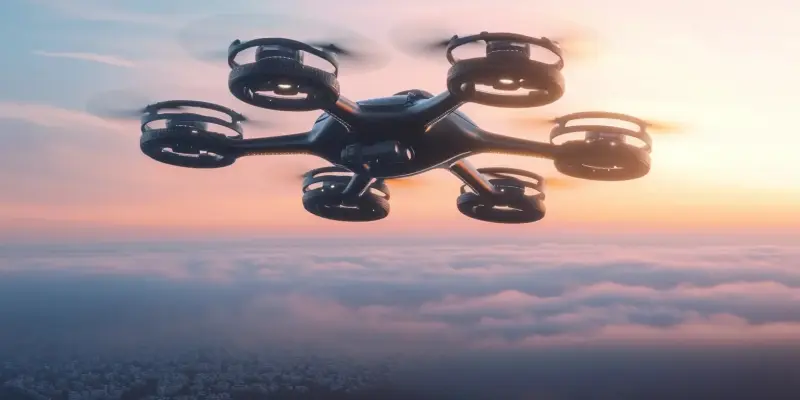In the rapidly evolving landscape of drone technology, ensuring the safety, security, and efficiency of Unmanned Aircraft System (UAS) operations is becoming increasingly critical. Terra Drone Corporation, through its group company Unifly, is making significant strides in this area by integrating innovative technologies such as blockchain and Open Service Navigation Message Authentication (OSNMA). The Certiflight project, which successfully completed its demonstration at the Port of Antwerp-Bruges (PoAB), stands as a prominent example of how these advancements can revolutionize drone operations, especially in congested airspace.
The Certiflight Project
Integrating Blockchain into UTM Systems
The Certiflight project, initiated in November 2022, is centered around the idea of securely recording flight data using blockchain technology. This ensures that any data related to low-altitude flights, whether from drones or general aviation flights, is protected against unauthorized modifications. The primary aim is to enhance the security and reliability of flight data, contributing significantly towards the widespread adoption of Beyond Visual Line of Sight (BVLOS) drone operations. By leveraging blockchain technology, Certiflight facilitates real-time transmission of flight data to operators and certification portals, making it easier for air traffic controllers to validate flight authorizations efficiently.
One of the standout features of the Certiflight project is its utilization of OSNMA technology. This innovation encompasses a broader range of security measures by implementing advanced satellite-based navigation signal authentication. The integration of OSNMA with blockchain ensures that drone operations within congested airspace are managed with heightened accuracy and security. This combination not only helps in protecting flight data from tampering but also enables more foolproof flight authorizations, creating a safer and more efficient UTM ecosystem. The demonstration at the Port of Antwerp-Bruges showcased how these technologies could be seamlessly integrated to provide a practical solution to the challenges faced in drone operations.
Demonstration and Key Achievements
The demonstration phase of the Certiflight project commenced in November 2024, with the goal of validating various drone operation scenarios by January 2025. This phase involved multiple U-space service providers and included trials in Belgium, Italy, and the Czech Republic. A significant highlight was the port surveillance demonstration conducted at PoAB in partnership with drone operator Sky Vision. The demonstration focused on the integration of Unifly’s UTM system with drones equipped with Digital EGNSS/IoT devices. This setup allowed for real-time monitoring and improved flight approval processes, showcasing the potential of these technologies in practical applications.
Key achievements from this demonstration included real-time visualization of drone flight paths and accurate positioning data. The use of OSNMA technology and blockchain integration ensured robust data security and reliability. Unifly’s UTM platform effectively demonstrated its capability to secure drone positioning for high-risk operations in complex airspaces. This was particularly important as it underscored the platform’s effectiveness in facilitating safe U-space airspace integration, which is crucial for promoting seamless operations of next-generation aircraft in shared environments. These accomplishments provided a clear demonstration of how advanced UTM technology could be employed to enhance the safety and efficiency of drone activities.
Future Implications and Expansion
Potential of Advanced UTM Technology
The successful demonstration of the Certiflight project has significant implications for the future of drone operations, particularly in high-risk and congested areas. By showcasing the practicality and efficiency of integrating blockchain and OSNMA technologies, Terra Drone has paved the way for broader adoption across various sectors. This includes port operations, urban air mobility, and other areas where safe and efficient drone activities are paramount. The advanced technology demonstrated by Unifly’s UTM platform indicates a promising future where drones can operate seamlessly even in the most challenging environments.
Moreover, the potential expansion of this technology beyond traditional applications highlights its flexibility and robustness. The ability to securely record and authenticate flight data can be extended to other use cases, such as emergency response, infrastructure inspections, and delivery services. Each of these scenarios benefits from the enhanced data accuracy and security offered by blockchain and OSNMA integration. As more sectors recognize the value of these technologies, the adoption is expected to increase, leading to more sophisticated and reliable drone operations worldwide.
Contributing to Overall Safety and Efficiency
In the fast-changing world of drone technology, it is becoming increasingly vital to ensure the safety, security, and efficiency of Unmanned Aircraft System (UAS) operations. Terra Drone Corporation, through its subsidiary Unifly, is making notable progress in this field by integrating cutting-edge technologies like blockchain and Open Service Navigation Message Authentication (OSNMA). The Certiflight project, which recently completed a successful demonstration at the Port of Antwerp-Bruges (PoAB), showcases how these technological advancements can revolutionize drone operations, especially in congested airspace. By combining these innovations, Terra Drone Corporation aims to pave the way for more reliable and secure drone usage, addressing the challenges posed by densely populated and high-traffic areas. These advancements not only enhance the safety and security of UAS operations but also increase their efficiency, thereby opening up new possibilities for the future of drone technology and applications in various industries.

